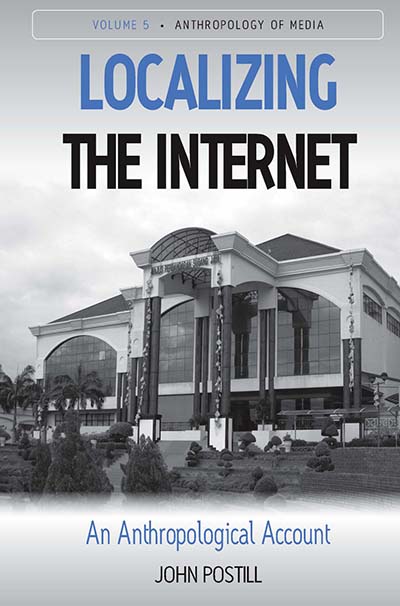 At a critical time of democratic reform across many parts of Southeast Asia, the suburb of Subang Jaya is regarded as Malaysia’s electronic governance laboratory. The focus of Localizing the Internet is Subang Jaya’s field of residential affairs, a digitally mediated social field in which residents, civil servants, politicians, online journalists, and other social agents struggle over how the locality is to be governed at the dawn of the Information Era. Richard Hanstock finds much of interest for sociologists, media theorists, and anthropologists.
At a critical time of democratic reform across many parts of Southeast Asia, the suburb of Subang Jaya is regarded as Malaysia’s electronic governance laboratory. The focus of Localizing the Internet is Subang Jaya’s field of residential affairs, a digitally mediated social field in which residents, civil servants, politicians, online journalists, and other social agents struggle over how the locality is to be governed at the dawn of the Information Era. Richard Hanstock finds much of interest for sociologists, media theorists, and anthropologists.
 Localizing the Internet. John Postill. Berhahn Books. September 2011.
Localizing the Internet. John Postill. Berhahn Books. September 2011.
In a New York Times op-ed last week, Estonian President Toomas Ilves praises the leaps forward that his country has made in digital governance. For Ilves, “[i]dentity lies at the core of security online”. He describes a state-guaranteed authentication system underpinning the trust that is crucial to combating “cyberinsecurity” in the late modern environment. Effective governance in our hyperconnected world will be a hot topic in politics for decades to come, adding to the importance of studies such as Postill’s Localizing the Internet. Postill asks us to take special care when building, reinforcing, and studying networked communities, so as to avoid allowing ‘the local’ to give way to the juggernaut of translocality.
Localizing the Internet explores digital activism in Subang Jaya, Malaysia’s suburban ‘Internet laboratory’, in theorising the role of the Internet in the development and reinforcement of social life and governance. Though principally located in the field of media anthropology, Postill’s insights are useful for the analysis of social structures whether or not they involve the Internet. Accordingly, this study will appeal to a wide readership of anthropologists, political scientists, sociologists, and journalists alike.
Chapter 2 brings the reader up to speed with the political and economic backdrop to the research setting, so readers unfamiliar with Malaysia need not be deterred. Subang Jaya is a suburban city southwest of Kuala Lumpur, whose rapid economic growth has come at significant social and environmental cost. Rubber and cocoa plantations gave way to housing developments and retail spaces from the 1970s onwards, transforming the ‘hutan’ (jungle) into a hotbed of affordable housing. Though Subang Jaya is principally an affluent area, Postill paints a picture of discontent, as a generation that saturated the area in search of ‘the Malaysian dream’ now struggles with lacking public services and the pressures of balancing professional and family lives (p. 36). The study follows politicians, activists, and residents in exploring the interactions that result from a collective desire to improve their local community.
Combining insights from Bourdieu with those of the Manchester School, Postill argues that his concept of the ‘field of residential affairs’ captures the constructive potential of the Internet in a way that the dominant ‘community/network’ paradigm does not. Postill gives shape to this field by plotting key individuals, institutions, and events along an ‘inverted T’: the public and private grassroots at the bottom, with local, state, and federal government ascending along the vertical axis. The role of the Internet is to mediate, not to impact upon, the competition and co-operation that naturally occurs within this field. The Internet does not flatten the ‘inverted T’ hierarchy, as the dominant paradigm might lead us to believe; rather, the asynchronous and flexible nature of networked life facilitates and encourages participation in local governance.
Postill’s precarious ‘proof of the padang’ pun (p.74) notwithstanding, the language is compelling, engaging, accessible, and concise. This slim volume is sandwiched between an introductory photographic essay introducing the key players in Subang Jaya, and a ‘Frequently Asked Questions’ section that summarises the core arguments and helps to direct the reader to the most relevant material. The ethnographic core of the book blends archival research with participant observation in providing a rich illustration of the field of residential affairs in Subang Jaya and its evolution.
The author makes excellent use of highlights from his fieldwork to illustrate his arguments. For example, Chapter 7 is punctuated with Internet-enabled ‘dramas’ in explaining the dynamics of participation in governance. Though the issues at the heart of these campaigns are relatively mundane – blocked drains (p. 89) and the building of a food court (p. 93) for example – this does not detract from the flow or force of Postill’s argument. The analysis is carefully structured along Turner’s four stages of social drama, and personal touches including recounts of conversations over coffee invite a sense of genuine attachment to the participants and their collective plight. Building upon earlier research on localisation in ‘new’ suburbs, Postill defends his focus on ‘banal activism’ by distinguishing community-building activities from translocal campaigns. Where previous studies focus on digital democratisation of national government, Localizing the Internet demonstrates the separate potential of the global network in democratising local governance.
A key message from Postill is that policymakers and researchers alike should avoid the temptation to conceive of ‘the community’ as a coherent entity. Chapter 4 opens with the story of the eventual demise of ‘SJ2005’, a federal e-governance project that sought to establish Subang Jaya as a ‘smart community’ by 2005. The project was beset by a lack of interest, stemming in part from low levels of consultation, and ultimately failed (p. 54). Participation was to be ensured by ‘community champions’ who, having bought into a central vision, would go forth and spread their enthusiasm within ‘the community’. This top-down approach of artificial stakeholding and opinion leadership rendered SJ2005 a federal project for ‘the community’, not a ‘community’ project for governance. In stark contrast, the genuinely grassroots ‘e-Community Portal’ USJ.com.my retains its dominant influence to this day: catching up on the publicly available forum posts on this website alongside Postill’s book makes the research setting seem all the more accessible.
The high degree of symbiosis between online and offline socialisation is a recurring theme in this book, captured well by the ‘inverted T’ model introduced above. The chronology is helpful in illustrating these links, but its ‘coloured threads’ require some imagination, as does visualising changes on the ‘inverted T’ chart as the field evolves over time. Diagrammatic illustration would enhance the otherwise clear conclusion.
Postill acknowledges that his research does not address questions of inclusivity and legitimacy in Internet-mediated governance, stating openly that his is “most emphatically not a digital divide study” (p. 27). This is just one of several invitations for further research. Others include the impact of the Internet on: the processes of place-making; interactions within the social field; legality and legitimacy in the field of residential affairs; and effects on processes of internalisation of centralised norms. Postill acknowledges that studying just one exceptional middle-class suburb cannot lend itself to general claims about the nature of networked life, nor to conclusions about whether campaigns would have happened ‘but for’ the Internet. However, this volume provides future researchers with a rich theoretical lexicon that enables studies in a range of disciplines to trade the ephemeral notion of ‘community’ for more measurable forms of sociality.
——————————————————-
Richard Hanstock is a barrister of Gray’s Inn, beginning pupillage at Three Raymond Buildings this autumn. He is presently reading an MPhil in Criminological Research at the University of Cambridge, where his primary research interest concerns the causes of Internet crime. His current research, generously supported by the ESRC, focuses on the extent to which illegal downloading can be described as an instance of moral rule-breaking. He has a LinkedIn profile, and blogs at ecrimeblog.com. Read more reviews by Richard.







